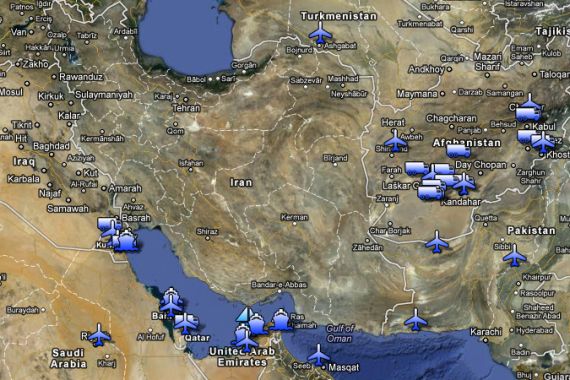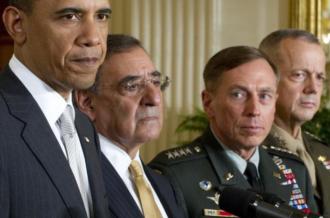Map: US bases encircle Iran
Dozens of US and allied forces’ military installations dot the region, from Oman, UAE and Kuwait to Turkey and Israel.

Doha, Qatar – US military bases continue to form a strategic envelope around Iran, although the American withdrawal from Iraq at the end of 2011 may have changed the regional balance somewhat towards Iran’s favour. While US forces are scaling back in many parts of the globe due to budget cuts – and have begun a gradual depature from Afghanistan to be completed by 2014 – their international presence remains vast.
From an active-duty force of 1.4 million soldiers, the US has deployed some 350,000 troops to at least 130 foreign countries around the world. Some are at Cold War-era installations, but many are in or near combat zones in the Middle East. At more than 750 bases internationally, private contractors and third-country nationals also form a large percentage of the staff, in addition to military reservists and civilian employees of the Pentagon.
Keep reading
list of 4 itemsMapping pro-Palestine college campus protests around the world
Satellite images reveal Israeli destruction of hospitals in Gaza
Mapping Israel-Lebanon cross-border attacks
US military installations in the Middle East serve to keep an eye on Iran, but their regional footprint was significantly expanded well before Iran became the most publicly cited foreign “threat”.
There were three reasons why the US sought a presence across the Middle East, says Mehran Kamrava, Director of the Center for International and Regional Studies at Georgetown University’s School of Foreign Service in Qatar:
“Securing oil resources, guaranteeing the security of the state of Israel and combating threats to American interests” were the initial priorities of US military activity in the region prior to the first Gulf War, Kamrava says.
“Subsequently, direct military presence wasn’t in the form of impositions, but the [security umbrella] was a conscious policy decision on the part of the Persian Gulf states.”
Click on installations for more information about facilities and troops, or view American Military Bases near Iran in a larger map
Kamrava says US forces “have the ability to project force when needed, by intimidating and signalling to potential threats that the US can flex its muscles if necessary … This is a combination of ‘showing the flag’ and practical, logistical issues such as the movement of troops, supplies and services”.
“So, these bases are not necessarily because of Iran, but certainly Iran has given the US a compelling reason to further the number of bases,” Kamrava told Al Jazeera. “But it doesn’t take a rocket scientist to figure out that Iran is encircled militarily.”
Since tensions with Iran further escalated in early January, a map of assumed locations of bases in the vicinity of the Islamic Republic has been circulating across various social media platforms. But our map, above, reflects the latest information, either officially acknowledged by the US military, sourced in the media or described on military information sites such as Global Security.
Prior to the September 11, 2001, attacks in the US, most of the American military abroad was stationed in Europe and East Asia. But the number of Middle East deployments climbed dramatically during subsequent campaigns in Iraq and Afghanistan.
The wide range and function of the new facilities became expedient to the simultaneous fighting of two massive wars on either side of Iran.
A decade ago in 2002, Rear Admiral Craig R Quigley, senior spokesman at US Central Command (CENTCOM) in Tampa, Florida, said: “There is great value, for instance, in continuing to build airfields in a variety of locations on the perimeter of Afghanistan that, over time, can do a variety of functions, like combat operations, medical evacuation and delivering humanitarian assistance.”
And while the US largely shifted its military focus to the region, it also moved most troops out of Saudi Arabia and into other Arab states of the Gulf, where US-friendly governments ironed out new security and basing arrangements.
Massive troop presence
According to new CENTCOM figures given to Al Jazeera on April 30, there are about 125,000 US troops in close proximity to Iran: 90,000 soldiers in/around Afghanistan on Operation Enduring Freedom; some 20,000 soldiers deployed ashore elsewhere in the Near East region; and a variable 15-20,000 afloat on naval vessels.
US Defence Secretary Leon Panetta has said the US would have 40,000 troops in the Gulf following the withdrawal from Iraq. But the exact number, location and mission of these forces beyond Afghanistan is virtually impossible to determine.
“We are obliged to respect the stated desires of various host countries, who have asked that we not acknowledge details of any US presence on their sovereign soil,” Oscar Seara, public affairs officer at CENTCOM, told Al Jazeera in an email.
“Partner-nation sensitivities limit what we are able to say about our military relationships,” Seara said, when asked to confirm or deny information about the bases in the map above.
 |
| President Obama announces the nominations of Leon Panetta and David Petraeus in 2011 [AFP] |
The troop tally released on December 31, 2011, by the Defense Manpower Data Center reported 57,479 “undistributed” troops around the world – on unknown assignment in unspecified locations. The organisation’s data department declined to clarify whether a significant number of these troops are stationed in the Middle East.
In the Gulf, CENTCOM spokesman Seara only confirmed that the “Fifth Fleet is headquartered in Bahrain. For anything else, you’ll have to contact the Bahraini Ministry of Defence … We can confirm Camps Arifjan, Buehring and Patriot. For anything else, you’ll have to contact the Kuwaiti Ministry of Defence.”
Despite such official efforts to remain inconspicuous in the post-9/11 era, US forces from the Air Force, Army, Navy and Marines are boldly positioned in Oman and the UAE to the south of Iran, Turkey and Israel to the west, Turkmenistan and Kyrgyzstan to the north, and Afghanistan and Pakistan in the east.
In addition, the US has close military partnerships with Georgia and Azerbaijan in the Caucasus, where US troops are involved in training missions, and where local facilities are used in moving supplies across the Caspian Sea towards Afghanistan.
When Pakistan closed NATO supply routes into Afghanistan, Central Asian countries such as Uzbekistan and Tajikistan became even more crucial for shipping non-lethal goods through the Northern Distrbution Network into the conflict zone to the south. Fears of a new “Great Game” emerged, as the US began more directly competing with Russia and China for regional influence.
While 2012 has clearly seen a US military buildup in the Gulf, especially an increase in the size of the standby combat force in Kuwait, the extent of troop movements is obscured by official secrecy surrounding the “globe-spanning American archipelago of bases“.
The Pentagon has said it is now prioritising smaller, more nimble deployments to work in partnership with local troops, rather than emphasising the sheer number of “boots on the ground”. And officials say an enhanced presence in the Gulf is meant to serve as a “quick-reaction and contingency force“, not simply a prelude to war.
Floating bases
In addition to the sites in the map above, the US Navy has announced the summer 2012 launch of a floating mothership base likely to be deployed in the Gulf. The converted USS Ponce warship is slated to be used by the Navy on anti-piracy missions and for “containment” of Iran. While aircraft carriers must move regularly around the Gulf, the new ship will be able to remain in the same place for weeks.
“There are two aircraft carrier strike groups operating in the US Fifth Fleet AOR [Area Of Responsibility],” Lt Rebecca Rebarich, US Fifth Fleet spokeswoman, told Al Jazeera in an email.
“Aircraft carrier USS Enterprise (CVN 65) is operating in the Arabian Sea, conducting missions in support of Operation Enduring Freedom,” Rebarich said. “Aircraft carrier USS Abraham Lincoln (CVN 72) is conducting maritime security operations in the Arabian Gulf.”
“There are approximately 16,000 personnel at sea aboard more than 40 US Navy, Coast Guard and fleet auxiliary ships in the US Fifth Fleet AOR.”
 |
| USS Enterprise, nicknamed “Big E”, has been deployed in almost every conflict and crisis around the world but will be decommissioned in December 2012 [EPA] |
France also has a nuclear-powered aircraft carrier, the Charles de Gaulle, which was reported to be heading to the Gulf in February.
For its part, France in 2009 established Peace Camp, a naval air station in Abu Dhabi. While the base is officially not just directed towards Iran, the dominant power on the other side of the Gulf then responded with a statement rejecting “increased foreign military presence” in the region.
Although US installations in Turkey, Israel, Djibouti and Diego Garcia are not in the CENTCOM area of responsibility, they could also be used in the event of any conflict with Iran.
Besides the bases shown on the map above, there are additional US micro-bases, as well as sites belonging to other countries that are used by US troops but not acknowledged as bases, and covert installations that are suspected but not confirmed.
As explained by Chalmers Johnson, the US author who coined the term “empire of bases“, the defence department’s 2011 report omits espionage bases, as well as facilities located in warzones and other sensitive places.
US commandos are also deployed throughout the region as part of the Special Operations Command (SOCOM), which conducts clandestine activities with a combined force of Army Green Berets and Rangers, Navy SEALs, Air Force Commandos and Marine Corps Special Operations teams.
Follow Ben Piven on Twitter: @BenPiven